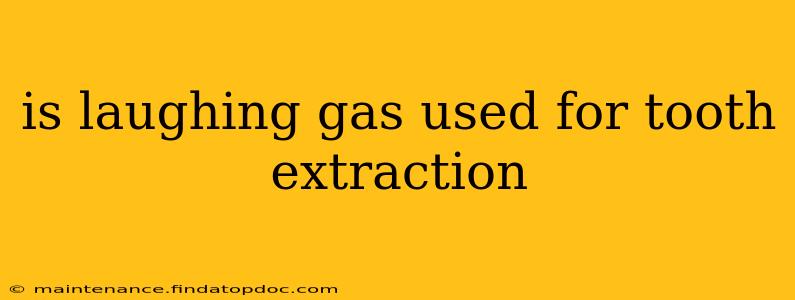Laughing gas, or nitrous oxide, has a long and fascinating history in dentistry, and its use for tooth extractions remains a relevant topic. While not used exclusively for extractions, it's a common and valuable sedative often incorporated into the procedure to enhance patient comfort and manage anxiety. Let's delve deeper into this topic.
What is Laughing Gas (Nitrous Oxide)?
Nitrous oxide is a colorless, odorless gas that's a mild sedative and analgesic. When inhaled, it produces a feeling of relaxation and euphoria, hence the nickname "laughing gas." Its effects are relatively short-lived, wearing off quickly once administration ceases. Crucially, it doesn't cause complete unconsciousness, allowing patients to remain alert and responsive throughout the procedure.
How is Laughing Gas Used During Tooth Extraction?
The dentist or oral surgeon will administer nitrous oxide through a small mask placed over your nose. The gas is mixed with oxygen to ensure safety and control the level of sedation. The effects usually begin within minutes, providing a calming and pain-reducing effect. The level of sedation is completely customizable to the individual patient's needs and tolerance.
Does Laughing Gas Eliminate All Pain During Tooth Extraction?
While laughing gas significantly reduces pain and anxiety, it doesn't typically eliminate all pain entirely. For more extensive extractions or those involving significant discomfort, the dentist will likely use local anesthesia to numb the area completely. Laughing gas acts as a valuable supplement to local anesthesia, enhancing the patient’s overall comfort and reducing their perception of pain and discomfort.
Is Laughing Gas Safe for Tooth Extraction?
Nitrous oxide is generally considered safe when administered by trained professionals. The concentration of the gas is carefully monitored throughout the procedure, and the effects are easily reversible. However, like any medical procedure, there are potential side effects, though they are generally mild and infrequent. These can include nausea, dizziness, or drowsiness. Patients with certain medical conditions (like respiratory issues) may not be suitable candidates. A thorough medical history discussion with the dentist is crucial to ensure safety.
What are the Advantages of Using Laughing Gas for Tooth Extraction?
- Reduces Anxiety: Laughing gas effectively calms nerves and alleviates dental anxiety, making the extraction experience far more comfortable for many patients.
- Pain Relief: It provides mild pain relief, supplementing local anesthesia to enhance comfort levels.
- Rapid Onset and Recovery: The effects start quickly, and recovery is typically rapid.
- Safe and Controlled: When administered by trained professionals, it's a relatively safe and controllable sedative.
What are the Disadvantages of Using Laughing Gas for Tooth Extraction?
- Not a Complete Anesthetic: It doesn't eliminate pain completely and usually requires local anesthesia as well.
- Potential Side Effects: Although rare, side effects such as nausea or dizziness are possible.
- Not Suitable for Everyone: Individuals with certain medical conditions may not be suitable candidates.
Is Laughing Gas Better Than Other Sedation Methods?
The choice of sedation method depends heavily on individual needs and the complexity of the procedure. Other options include oral sedation, IV sedation, and general anesthesia. Laughing gas offers a good balance of effectiveness, safety, and ease of use, making it suitable for many patients. However, for more complex cases or individuals with severe anxiety, more potent sedation options may be necessary. Your dentist will recommend the best approach based on your specific circumstances.
Does Laughing Gas Have Any Long-Term Effects?
No, nitrous oxide generally has no long-term effects when used properly in controlled dental settings. Its effects are entirely reversible, and there's no accumulation of the gas in the body.
This information should not be considered medical advice. Always consult with your dentist or oral surgeon to discuss the best approach for your tooth extraction. They will assess your individual needs and determine the most appropriate sedation method for a comfortable and safe procedure.
